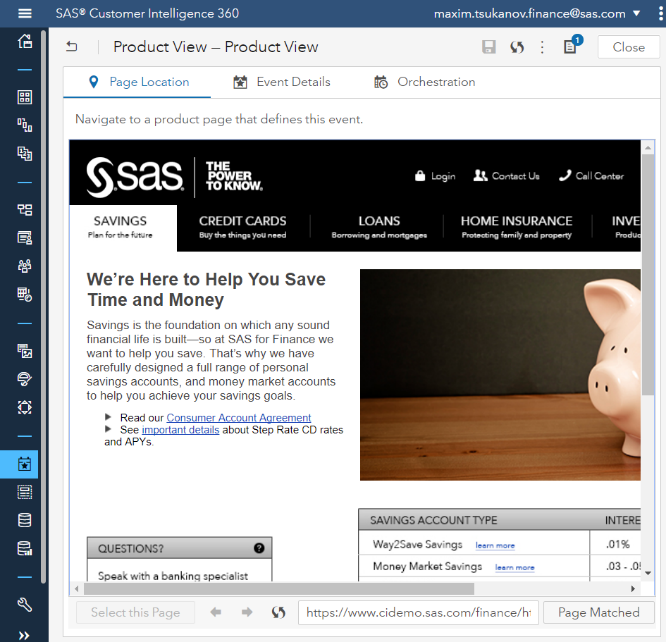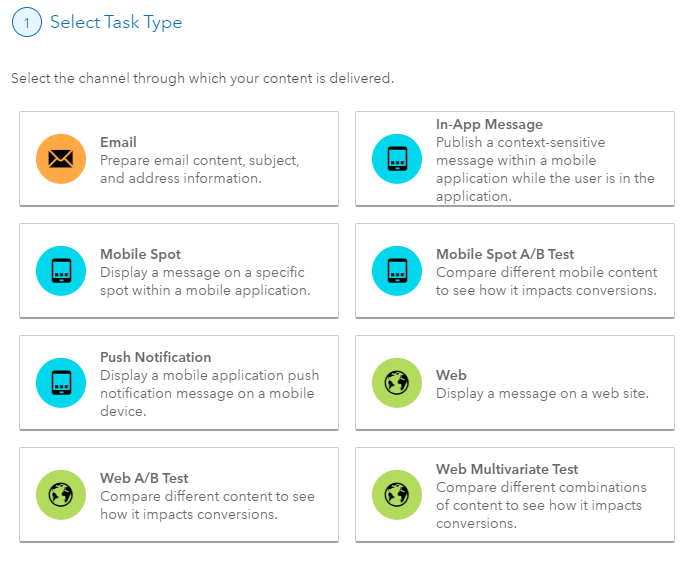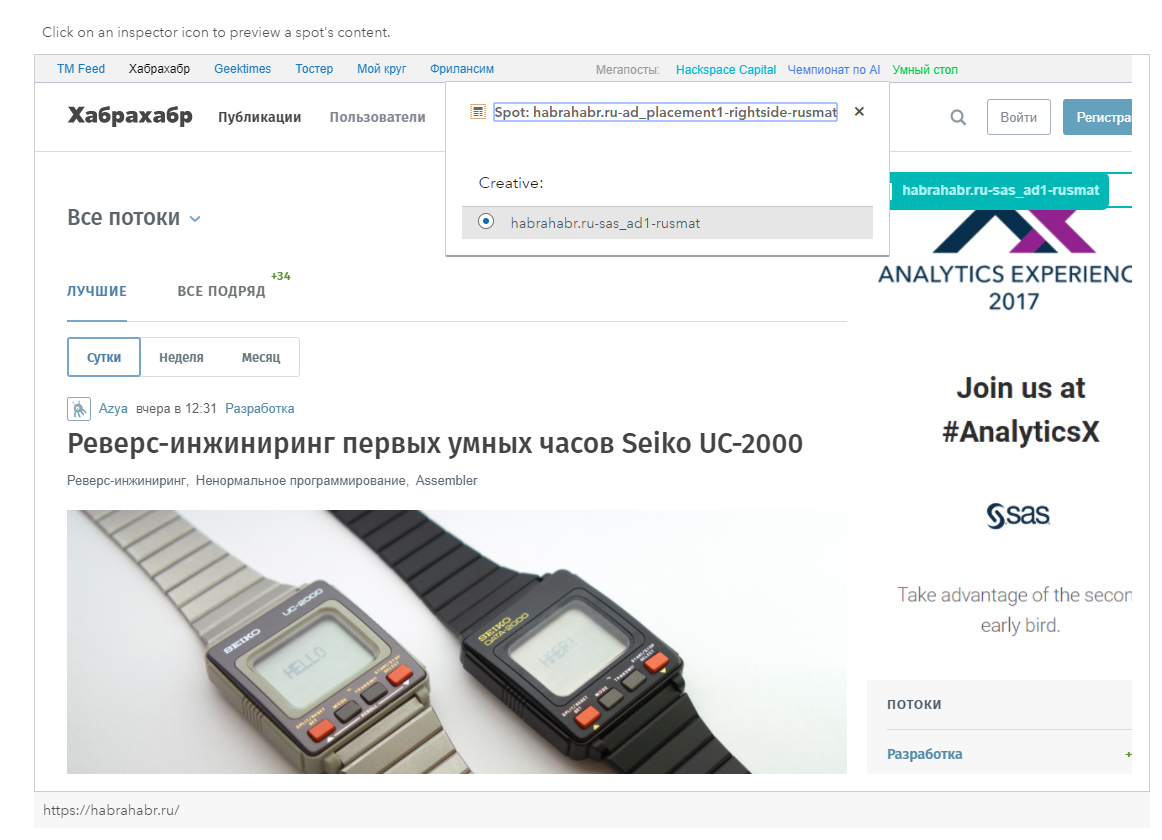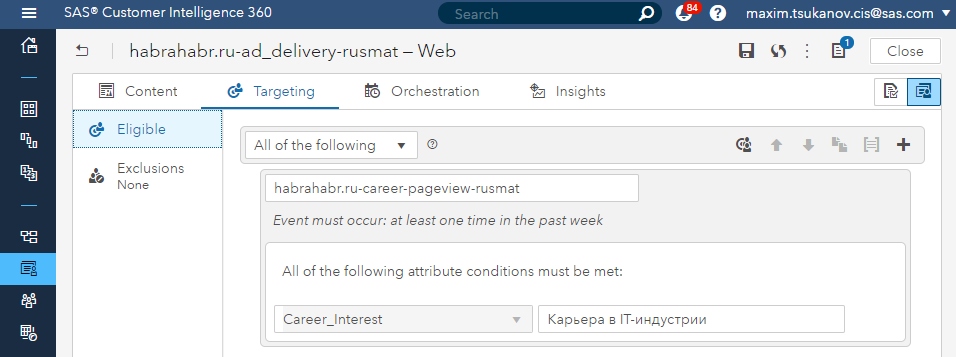One-stop digital marketing: dismantling SAS cloud products
My name is Max, and I work as a client analyst consultant at SAS (this is not a special forces or an airline, but an institute). We evaluate the applicability of new technologies in business processes of various industries and on the basis of this we make projects. Including in digital marketing. I will share the most interesting results of our work with you in this and subsequent publications.
Today's hero is a cloud-based product for digital marketing, SAS Customer Intelligence 360, which allows you to centrally collect and process customer data. Analysis of opportunities and examples of work - under the cut.

Digital has sneaked in unnoticed from social networks, search engines, mobile phone screens and various wearable devices.
')
 You quickly get used to the comfort of the modern Internet, the once unusually high level of service is becoming commonplace and corresponding to the minimum "must have".
You quickly get used to the comfort of the modern Internet, the once unusually high level of service is becoming commonplace and corresponding to the minimum "must have".
In order to hopelessly keep up with the needs of their customers, companies are forced to rush forward in the race of digital customer services.
What problems do organizations face when working with digital channels? There are many of them, but we single out the three most acute ones:
In order to successfully solve these and other problems, we developed SAS Customer Intelligence 360. This solution is distributed through the SaaS model and so far includes two modules - for collecting data on user behavior (Discover) and for managing customer travel and personification (Engage).
A few customers are going through closed testing with two more modules - email management and marketing initiatives (MRM). We plan to regularly update existing modules and add new ones. All updates occur automatically, without the participation of users.

Currently, SAS Customer Intelligence 360 consists of two modules
Unlike traditional SAS products, the solution is based in the cloud. This is a typical approach for the implementation of SaaS-solutions, which does not require the user to purchase additional “hardware”, and we did not go against the industry trends.
The cloud implementation also has additional advantages: flexible management of consumed services, automatic updating and quick start at the beginning of work (it takes me less than 10 minutes to connect a new site).
“Cloudy” requires increased attention to security aspects and data transmission issues, including personal ones. In Customer Intelligence 360, all connections are encrypted using the https protocol (TLS 1.2), and you can “ obfuskirovat ” the values when collecting data.
On the client browser side, SHA-384 hashing is performed. If the data suddenly falls into the wrong hands, the process of recovering values from the hash will be extremely difficult and unprofitable (as opposed to data encryption, when it is enough to know the correct passphrase for decryption). When the hashed data falls into the cloud, it is re-hashed with different parameters. Requirements for hashing are made when batch (for example, from CRM) uploading personal data to the cloud - SAS does not allow storing it in the clear.
The data is collected in a special cloud storage - DataHub, where the impersonal visitor profiles of all connected sites, mobile devices, information about their behavior in the connected online and offline channels are located. DataHub can be expanded - just prepare the table and send it to the cloud, specifying the "keys" in a certain way. Then DataHub will connect the new table with already available data. Binding is carried out in the context of visitor profiles.
Now let's take a closer look at the components of the solution. Let's start with the Discover module .
All collect data on the work of the site, but not all have the ability to form a single omni-channel client profile and automatically load the collected information into a normalized data mart without resorting to the need to write code or perform some complex integrations. And SAS 360 Discover is able to do it. Most of the client’s actions are collected automatically immediately after the tag is added to the site. To track more complex events or processes, use the setup wizard, which allows you to flexibly configure the system. And yes, you do not need to write code.

 Settings for rule collection are set through the administrator interface - no need to further modify the site
Settings for rule collection are set through the administrator interface - no need to further modify the site
“Okay,” someone will say, “any solution has limitations, not all events on the site can be collected. What to do in this case? Without panic, it is also provided for. It is possible to send events directly to SAS 360 Discover by simply calling the RESTful service via API. In the simplest form, the request body will look like these two examples:
To collect data from the mobile there is a special SDK, which is easy to attach to an application for Android or iOS. Data collected from different devices is accumulated in a single showcase and is always available.
Now let's talk about engagement - the “Engage” module .
Having such valuable intelligence at hand, it would be a crime not to use them. All that is known about the site visitor can be usedagainst him for more precise targeting.
And the matter is not limited to trivial mechanics like “catch up with the user at any cost” (by the way, we in SAS strongly oppose such spam). The solution allows you to elegantly “manage” such important issues as contact policy, testing, base segmentation and analysis of the effectiveness of online campaigns. You can download a list of clients from CRM, select content for communication, set up campaign rules and performance indicators and monitor its success - within a single user interface.
Built-in analytical assistants allow you to conduct various A / B testing, optimize communications, profile customer base and select products or services for the client.
For example, let's analyze the implementation of simple communication in 360 Engage. For now, let’s lower the creation of a banner, the setting of the place where a banner is displayed, the choice of an audience, and the creation of events (we plan to talk about this in new publications) and limit ourselves to the task setting stage.
Tasks come in different types and for different channels. Today, web, mobile and email are available. For example, choose the web - this is the easiest of them. The web task configuration interface will open. We indicate in which spot what content (creatives, banners) to output.

Types of tasks
Additionally, we indicate the limitations of the contact policy. You can set the maximum number of banner impressions for a specific user for the entire duration of the campaign or for a certain period (session or a certain period of time). Another parameter is the duration of the task relevance (for example, the time of the campaign). When the “hour X” comes, the campaign will automatically end.

Contact Policy
To make sure that creatives (banners) will be correctly displayed on the site, you can use the preview.

An example of a preview on the site
360 Engage allows you to customize the type of audience that is suitable for this campaign — for example, to select customers based on their behavior on the network and / or data downloaded from external systems (for example, from CRM). In our case, we will limit the audience of the task to those users who visited the page https://habrahabr.ru/hub/career/ and read articles about their careers in the IT industry. You can also configure the system so that users will not see the banner if, for example, they have seen the same or have already performed some target action.

Audience selection
To implement more complex customer interaction scenarios, you can customize the activity map — a diagram that displays the client's path in digital channels. Each next step on the activity map is selected depending on the behavior of the user in the previous step. A nice feature - you can conduct A / B testing of entire processes (several combined steps). Activity maps are another subject of future publications.

Activity cards allow you to build multi-step customer interaction scenarios
Recently, I looked at the SAS Customer Intelligence 360 roadmap, and it became obvious to me that this is no longer just an extension of the digital capabilities of the “classic” solutions of traditional SAS targeted marketing. SAS Customer Intelligence 360 is slowly but surely turning into a self-sufficient Digital Marketing platform. Integration is being finalized (external DMP and traditional channels), models of analytical assistants are polished (extended segmentation and product recommender), new “features” are added to the existing tools (multi-page A / B testing and online content personalization). With each release, the built-in MRM functionality increases.
I am ready to answer all your questions on SAS Customer Intelligence 360 in the comments.
Today's hero is a cloud-based product for digital marketing, SAS Customer Intelligence 360, which allows you to centrally collect and process customer data. Analysis of opportunities and examples of work - under the cut.

Day D
Digital has sneaked in unnoticed from social networks, search engines, mobile phone screens and various wearable devices.
')
 You quickly get used to the comfort of the modern Internet, the once unusually high level of service is becoming commonplace and corresponding to the minimum "must have".
You quickly get used to the comfort of the modern Internet, the once unusually high level of service is becoming commonplace and corresponding to the minimum "must have".In order to hopelessly keep up with the needs of their customers, companies are forced to rush forward in the race of digital customer services.
What problems do organizations face when working with digital channels? There are many of them, but we single out the three most acute ones:
- The increasing complexity of identification. The same clients simultaneously interact with different digital channels. The capabilities of traditional web analytics for comprehensive monitoring are not enough here. The implementation of individual cases does not lead to the creation of a universal means of customer relationship management in digital channels.
- The increasing rate of change. It is time to recognize that retrospective data analysis in the modern world loses its value. Of course, reports on the performance of a site or a mobile application based on terabytes of clickstream data look impressive. However, it turns out that they carry little value for business. They perfectly illustrate the past - but they say nothing about the future.
- Increasing amount of information. Visitors to online stores or banking sites can generate a huge stream of data about themselves and their behavior. All this information needs to be able to use. But data on digital channels is only part of the overall picture, which will remain incomplete without data from offline sources. With incomplete source data it is difficult to succeed, even using the most modern tools, for example, datamining or predictive analytics.
What to do?
In order to successfully solve these and other problems, we developed SAS Customer Intelligence 360. This solution is distributed through the SaaS model and so far includes two modules - for collecting data on user behavior (Discover) and for managing customer travel and personification (Engage).
A few customers are going through closed testing with two more modules - email management and marketing initiatives (MRM). We plan to regularly update existing modules and add new ones. All updates occur automatically, without the participation of users.

Currently, SAS Customer Intelligence 360 consists of two modules
Unlike traditional SAS products, the solution is based in the cloud. This is a typical approach for the implementation of SaaS-solutions, which does not require the user to purchase additional “hardware”, and we did not go against the industry trends.
The cloud implementation also has additional advantages: flexible management of consumed services, automatic updating and quick start at the beginning of work (it takes me less than 10 minutes to connect a new site).
“Cloudy” requires increased attention to security aspects and data transmission issues, including personal ones. In Customer Intelligence 360, all connections are encrypted using the https protocol (TLS 1.2), and you can “ obfuskirovat ” the values when collecting data.
On the client browser side, SHA-384 hashing is performed. If the data suddenly falls into the wrong hands, the process of recovering values from the hash will be extremely difficult and unprofitable (as opposed to data encryption, when it is enough to know the correct passphrase for decryption). When the hashed data falls into the cloud, it is re-hashed with different parameters. Requirements for hashing are made when batch (for example, from CRM) uploading personal data to the cloud - SAS does not allow storing it in the clear.
The data is collected in a special cloud storage - DataHub, where the impersonal visitor profiles of all connected sites, mobile devices, information about their behavior in the connected online and offline channels are located. DataHub can be expanded - just prepare the table and send it to the cloud, specifying the "keys" in a certain way. Then DataHub will connect the new table with already available data. Binding is carried out in the context of visitor profiles.
Now let's take a closer look at the components of the solution. Let's start with the Discover module .
All collect data on the work of the site, but not all have the ability to form a single omni-channel client profile and automatically load the collected information into a normalized data mart without resorting to the need to write code or perform some complex integrations. And SAS 360 Discover is able to do it. Most of the client’s actions are collected automatically immediately after the tag is added to the site. To track more complex events or processes, use the setup wizard, which allows you to flexibly configure the system. And yes, you do not need to write code.


“Okay,” someone will say, “any solution has limitations, not all events on the site can be collected. What to do in this case? Without panic, it is also provided for. It is possible to send events directly to SAS 360 Discover by simply calling the RESTful service via API. In the simplest form, the request body will look like these two examples:
{ "eventName":"Habr Event", "visitor_id":"4f7da12598693fa49211123" } { "eventName":"Another Habr Event", "datahub_id":"1234w5-w451w-q72303" } To collect data from the mobile there is a special SDK, which is easy to attach to an application for Android or iOS. Data collected from different devices is accumulated in a single showcase and is always available.
Now let's talk about engagement - the “Engage” module .
Having such valuable intelligence at hand, it would be a crime not to use them. All that is known about the site visitor can be used
And the matter is not limited to trivial mechanics like “catch up with the user at any cost” (by the way, we in SAS strongly oppose such spam). The solution allows you to elegantly “manage” such important issues as contact policy, testing, base segmentation and analysis of the effectiveness of online campaigns. You can download a list of clients from CRM, select content for communication, set up campaign rules and performance indicators and monitor its success - within a single user interface.
Built-in analytical assistants allow you to conduct various A / B testing, optimize communications, profile customer base and select products or services for the client.
For example, let's analyze the implementation of simple communication in 360 Engage. For now, let’s lower the creation of a banner, the setting of the place where a banner is displayed, the choice of an audience, and the creation of events (we plan to talk about this in new publications) and limit ourselves to the task setting stage.
Tasks come in different types and for different channels. Today, web, mobile and email are available. For example, choose the web - this is the easiest of them. The web task configuration interface will open. We indicate in which spot what content (creatives, banners) to output.

Types of tasks
Additionally, we indicate the limitations of the contact policy. You can set the maximum number of banner impressions for a specific user for the entire duration of the campaign or for a certain period (session or a certain period of time). Another parameter is the duration of the task relevance (for example, the time of the campaign). When the “hour X” comes, the campaign will automatically end.

Contact Policy
To make sure that creatives (banners) will be correctly displayed on the site, you can use the preview.

An example of a preview on the site
360 Engage allows you to customize the type of audience that is suitable for this campaign — for example, to select customers based on their behavior on the network and / or data downloaded from external systems (for example, from CRM). In our case, we will limit the audience of the task to those users who visited the page https://habrahabr.ru/hub/career/ and read articles about their careers in the IT industry. You can also configure the system so that users will not see the banner if, for example, they have seen the same or have already performed some target action.

Audience selection
To implement more complex customer interaction scenarios, you can customize the activity map — a diagram that displays the client's path in digital channels. Each next step on the activity map is selected depending on the behavior of the user in the previous step. A nice feature - you can conduct A / B testing of entire processes (several combined steps). Activity maps are another subject of future publications.

Activity cards allow you to build multi-step customer interaction scenarios
What's next?
Recently, I looked at the SAS Customer Intelligence 360 roadmap, and it became obvious to me that this is no longer just an extension of the digital capabilities of the “classic” solutions of traditional SAS targeted marketing. SAS Customer Intelligence 360 is slowly but surely turning into a self-sufficient Digital Marketing platform. Integration is being finalized (external DMP and traditional channels), models of analytical assistants are polished (extended segmentation and product recommender), new “features” are added to the existing tools (multi-page A / B testing and online content personalization). With each release, the built-in MRM functionality increases.
I am ready to answer all your questions on SAS Customer Intelligence 360 in the comments.
Source: https://habr.com/ru/post/343860/
All Articles